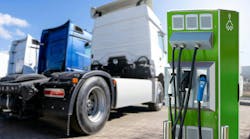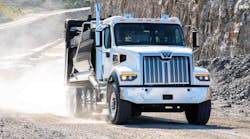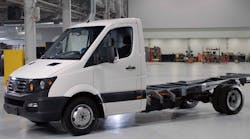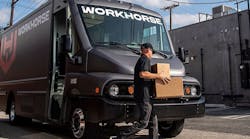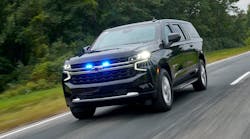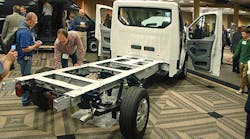THE all-new Ford F-650/F-750, which will be 2016 model year trucks, will be available in the spring.
The lineup will consist of eight models, including a dedicated tractor model. Regular, Super Cab, and Crew Cab models will be offered, powered by gasoline engines and the Ford Power Stroke diesel.
The F-650/F-750 features a second-generation 6.7-liter Power Stroke V8 diesel and medium-duty six-speed TorqShift automatic transmission.
The new mesh grille helps improve airflow for optimal cooling performance. Also new are redesigned fenders, aerodynamic headlamps and available PowerScope trailer tow mirrors. The mirrors feature large standard and spotter mirrors. The assembly folds and telescopes electrically.
The area behind the cab was redesigned to more easily accommodate custom work bodies, such as tow truck, dump truck and ambulance bodies.
Before it goes on sale, it will have been tested by people and machines in labs, at Ford proving grounds and on America’s highways and city roads. Part of the F-650/F-750 testing includes Ford’s robotic test driving program—now in use at the company’s Michigan Proving Grounds in Romeo, Michigan—to meet demands that Ford trucks undergo.
Newly available for F-650/F-750 is the Ford-built 6.7-liter Power Stroke V8 diesel paired with a commercial-grade six-speed 6R140 automatic transmission with available power takeoff provision.
The F-650/F-750 6.7-liter Power Stroke and TorqShift have been developed and tested for medium-duty applications, with three horsepower and torque levels and a five-year/250,000 mile limited warranty.
Key innovations on the 6.7-liter Power Stroke V8 turbo diesel are its compacted graphite iron engine block and so-called reverse-flow layout. The advanced design improves a variety of attributes:
Shorter airflow from the exhaust system to the turbocharger sitting between the engine’s cylinder banks improves turbo responsiveness.
Positioning the turbo inside the engine’s valley helps isolate the engine’s hottest temperatures, helping improve performance and efficiency, while also reducing noise, vibration and harshness to improve driver comfort.
Power Stroke drivability is enhanced with tow/haul mode that includes a switchable integrated engine brake. The driver can regenerate the diesel particulate filter on-demand to clear out trapped soot from the exhaust system to help maximize performance. Intelligent Oil Change Monitoring is standard so oil changes are based on driving patterns and load demands instead of fixed distance intervals.
During testing, the 6.7-liter Power Stroke V8 endured the equivalent of 500,000-plus miles on an engine dynamometer, replicating the duty cycle of the harshest-use customer.
The fuel-efficient transmission features a low first gear ratio for optimized takeoffs under load and optimized gear ratio span across all gears for optimized fuel economy. It’s also strengthened with new materials and extra pinion gears for medium-duty service.
Ford continues to offer a gasoline-powered engine for a medium-duty truck. The 6.8-liter V10 is now available for both F-650 and F-750 models with the 6R140 six-speed automatic transmission. The 6.8-liter V10 can be factory-prepped for converting to compressed natural gas or liquid propane gas as cost-effective alternatives to unleaded gasoline.
Meanwhile, shipping has begun for the full line of Transit vans.
While all models are being produced, Ford has a round of options that will be offered shortly as “Job #2.” They include a safety system designed to alert the driver when the Transit leaves its lane, spray-in cargo floor liner, backup alarm, and 250-amp alternator.
The high-roof Transit—with 81.5 inches of maximum interior cargo height—provides enough headroom for a person 6-feet-8 inches tall to stand upright in the cargo area.
The new Transit van offers as much as 487 cubic feet of cargo volume and 4650 pounds of maximum payload capacity. The Transit van delivers a maximum towing capacity of 7600 pounds.
In some configurations, Transit offers as much as much as 75% more cargo volume than the largest E-Series, helping customers save in fuel costs and time associated with having to make a second trip. Maximum payload increases more than 600 pounds across the Transit van lineup versus comparable E-Series vans.
Transit will be available in three body lengths, two wheelbases on van and wagon and three roof heights; in van, wagon, chassis cab and cutaway body styles; and in XL and XLT trim levels.
Moving from an all-gasoline engine lineup of two V8s and a V10 in E-Series, Transit comes standard with a 3.7-liter V6 engine and offers the Ford F-150’s 3.5-liter EcoBoost engine, along with a globally proven available 3.2-liter Power Stroke diesel option. Each engine is paired with a six-speed automatic transmission for efficient rear-wheel-drive operation.
In addition to Transit, Kansas City Assembly Plant produces Regular, Super and Crew Cab versions of Ford F-150. The plant employs 4878 hourly workers on three crews. The third crew was added in the third quarter of 2013.
Ford has invested $1.1 billion to retool and expand the facility for Transit production. Expansion projects include the addition of a 437,000-square-foot stamping facility and a 78,000-square-foot paint shop.
The investment has also contributed to close to 550 new robots in the body shop, more than 700 new assembly tools in trim and chassis, and 18 new conveyor systems totaling 5565 feet.
The new investment also will support Kansas City Assembly’s production of the all-new Ford F-150 in 2015, after the truck launches at the Ford Dearborn Truck Plant in late 2014.
The Transit vehicles built in Kansas City are the first to use the new two-wet monocoat paint process developed by Ford and its paint suppliers. The technology results in more durable paint, uses less energy and water, and reduces carbon dioxide and particulate emissions compared with conventional paint processes.
The new paint was subjected to a battery of tests that simulates typical conditions the vehicle will see during 10 years. The paint was tested for its resistance to chipping and scratching, pollutants and sun exposure. Advanced weathering testing indicates that paint applied with the new two-wet technology will retain 90 percent of its gloss at four years in service compared to 1 percent gloss retention for paint applied using a conventional monocoat process.
In addition to making paint tougher, the process reduces painting time and energy use by cutting the number of paint applications from three to two and the number of drying procedures from two to one.
Ford plans call for a 30 percent reduction in carbon dioxide emissions per vehicle produced from 2010 to 2025, and a 30 percent reduction in water use per vehicle produced from 2009 to 2015.
The new paint process uses less energy and water, and reduces carbon dioxide and particulate emissions compared with conventional paint processes. The reduction in paint and energy consumed is expected to result in 9500 tons fewer carbon dioxide emissions and a 35-ton savings in particulate emissions on an annual basis. An innovative dry scrubber system will help save more than 10.5 million gallons of water. Overall, the system should save 48,000 megawatt hours of electrical power, enough electricity to power 3,400 homes.
The new paint procedure is being used for white-colored vehicles, which account for 80 percent of Ford Transit production at Kansas City Assembly Plant. As each color must be developed uniquely for the two-wet monocoat process, other colors will be considered based on demand. A conventional three-wet process – primer, base coat, clear coat – remains in use for metallic-colored vehicles. ♦

